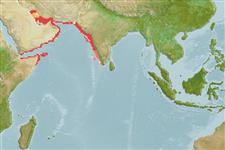Classification / Names
Common names from other countries
Main reference
Size / Weight / Age
Max length : 61.0 cm TL male/unsexed; (Ref. 30573); 54.7 cm TL (female); max. published weight: 0.00 g
Environment
Marine; demersal; depth range 10 - 155 m (Ref. 89707)
Climate / Range
Tropical, preferred ?; 33°N - 8°N, 44°E - 77°E (Ref. 5222)
Distribution
Western Indian Ocean: Gulf of Aden, Gulf of Oman, Persian Gulf, Pakistan, and west coast of India. Since it has only recently been discovered, it may be expected to have a wider distribution.
Countries | FAO areas | Ecosystems | Occurrences | Introductions
Short description
Dorsal
spines
(total): 11;
Dorsal
soft rays
(total): 16-17;
Anal
spines: 3;
Anal
soft rays: 8. Distinguished by the following characteristics: head, body and fins pale, covered with numerous small close-set dark brown spots; spots on fins and dorsal parts of head and body smaller and closer together compared to those on the sides and ventrally; rear edge of caudal fin with white line and a row of blackish brown spots; presence of dark maxillary streak; body depth contained 2.6-3.3 times in SL; body width 1.8-2.4 times in depth; head length 2.5-2.8 times in SL; slightly convex interorbital, dorsal head profile almost straight; angular preopercle, with indentation above the angle and enlarged serrae below the indentation; straight upper edge of operculum; posterior nostrils slightly larger than anterior ones; maxilla reaches to below rear half of eye; front of jaws with a pair of small fixed canines; 2 rows of teeth on midlateral part of lower jaw, inner ones twice length of outer teeth, pyloric caeca 28-34 (Ref. 89707).
IUCN Red List Status (Ref. 115185)
Threat to humans
Harmless
Human uses
Fisheries: commercial
More information
ReferencesAquacultureAquaculture profileStrainsGeneticsAllele frequenciesHeritabilityDiseasesProcessingMass conversion
Tools
Special reports
Download XML
Internet sources
Estimates of some properties based on models
Phylogenetic diversity index
PD50 = 0.5000 many relatives (e.g. carps) 0.5 - 2.0 few relatives (e.g. lungfishes)
Trophic Level
3.9 ±0.6 se; Based on size and trophs of closest relatives
Resilience
Medium, minimum population doubling time 1.4 - 4.4 years (K=0.19; tmax=41)
Vulnerability
Moderate to high vulnerability (46 of 100)
Price category
